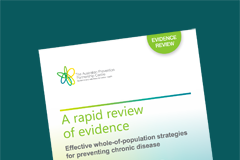Effective whole-of-population strategies for preventing chronic disease
The review explores whole-of-population prevention interventions that are most effective in slowing the growth in obesity and preventing significant modifiable risk factors for chronic disease.
Background
This rapid review is designed to identify, synthesise and interpret the latest evidence to provide a concise
summary of the current state of knowledge. Commissioned by the Australian Government Department of
Health, the review addresses the question: What whole-of-population prevention interventions have
been shown to be most effective, in Australia and or comparable jurisdictions overseas, in:
- Slowing the growth in population levels of obesity
- Preventing the most significant modifiable risk factors contributing to the burden of chronic disease
in Australia, namely poor diet, physical inactivity tobacco use and harmful alcohol consumption.
Key messages
- This is a rapid review of the evidence for potentially effective interventions that have been the
subject of high-quality reviews or meta-analyses since 2010. - The review indicates which interventions are likely to be effective based on the strength and
quality of evidence available for review. - The review found strong evidence of effectiveness for:
- Multi-component interventions targeting dietary intake in the workplace
- Group-based exercise programs and self-monitoring of physical activity in the workplace and broader community
- Counselling and support programs for smoking cessation in the workplace and community
- Support for employees to change behaviour to manage weight.
- While this review signals which interventions may be effective, complex problems such as
chronic diseases do not respond to simple, independent, one-off solutions. Rather, they
require a coordinated portfolio of sustained, whole-of-population and inter-sectoral actions. - Systems thinking and systems tools can help us to understand and manage the complexity
of chronic disease. These methods are used to examine system components and the dynamic
relationships between them.
